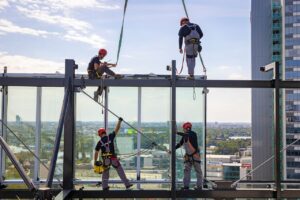Introduction
The construction site is an integral part of the construction process, which involves various material processes, tools, and construction methods necessary to create structures. Unfortunately, the presence of flammable materials or electrical systems increases the susceptibility of these sites to fire incidents. Flammable materials or electrical systems increase the risk of fire incidents. Hot work, such as welding or cutting, increases the risk of fire incidents. This article will likely be beneficial as fire prevention protects lives, property, and investments. Here are some primary ideas and ways to prevent fires at construction sites.
1. Conducting a comprehensive fire risk assessment will create many opportunities.
This necessitates conducting a thorough fire risk assessment before initiating construction work. This encompasses the potential for fire hazards, the likelihood of fire incidents, and the possible outcomes these fires could have. This assessment provides information to create an initial perception of the concrete dangers associated with the site and a foundation for developing a fire prevention plan.
2. The Fire Prevention Plan shall be developed and implemented in the following way.
A fire prevention plan (FPP) defines measures and actions to avoid fires. Information such as emergency contacts, the location of fire alarms, and evacuation routes should be readily available. The plan should also designate an individual or team responsible for implementing the strategy and ensuring compliance with safety measures.
3. Measures of Storing and Handling of Flammable Items
Construction sites stock products that have the potential to cause fire, such as fuel, solvent, and adhesive. To reduce fire risks:
Store them separately in cool, well-ventilated stations far from any ignition sources.
The use of flammable storage cabinets was feasible.
Make sure the store’s containers have accurate labels and closures.
4. Maintain Electrical Safety
Electrical work is one of the leading causes of fire outbreaks on construction sites. To mitigate these risks:
We must periodically inspect the wiring, circuits, and equipment.
Engage only standardized and well-maintained tools and equipment.
Avoid overloading circuits and ensure that a certified electrician completes the temporary wiring.
5. Control hot work activities.
The most common causes of fire in industrial areas are welding, cutting, and other hot work activities since they produce heat and sparks capable of igniting flammable materials. To minimize risks:
Implement a hot work permit for the safe and controlled execution of the activities.
Provide a fire watch during and after hot work activities.
Furthermore, keeping fire extinguishers and blankets readily available is essential.

6. Fire protection equipment installation and maintenance
Fire protection equipment is a significant tool for fire detection and prevention.
Key measures include:
Placing fire alarms and smoke detectors at appropriate positions within a building.
The task involves storing portable fire extinguishers and ensuring workers possess the necessary skills to use them effectively.
The use of fire barriers and fire partitions is one requirement to reduce the risks.
7. Compliance with Good Housekeeping Standards
These fuel fires and prohibit evacuation. Encourage workers to:
Clean periodically all waste materials, particularly those that are flammable.
The fundamental principle prohibits obstructing outlets, paths, corridors, and other accessibility points.
Secure your tools and equipment in the proper places.
8. Train workers in fire safety.
Education and enlightenment on fire prevention matters are crucial as they play a significant role in preventing fires. Conduct regular fire safety training sessions to ensure workers:
The goals of the different designs are as follows:
Understand the fire hazards specific to the site.
The knowledge and skills required to use fire protection gadgets and equipment are essential.
They are aware of emergency signs and signals as well as evacuation directions.
9. Organize the means of communication.
This implies that education and effective communication are crucial in the event of a fire. Use:
Whistles, two-way radios, or mobile communication gadgets transfer information from one department to another.
Sounds and light signals sound the alarm, prompting workers to take action, such as stopping work.
10. Cooperate with the local fire authorities
Consult the fire departments before initiating a project, particularly when construction commences. Their duties include recognizing other risks that might not be obvious and checking if the site meets the local code for safety from fire.
Conclusion
Prevention of fire incidents at construction sites is a collective responsibility that involves everyone in implementing fire safety measures, monitoring, and stringent cooperation.
These processes can significantly reduce fire hazards, create a safer employee environment, and preserve property. As much as fire prevention is about saving lives, it’s also about managing your budget and avoiding loss and project delays.
Also read about: Cost of Living in the USA in 2025


One Comment on “Fire Prevention on Construction Sites”